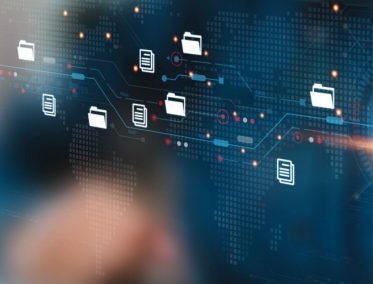Information residing in ERP systems is some of the most sensitive and critical data in an organization. Data security has become an enterprise-wide concern and increasingly business leaders are being called upon to help enhance cybersecurity and identify threats. In a recent survey of CFOs, 74% had data security concerns and 53% said they have data privacy and data loss concerns. Therefore, it is imperative that they understand where this information is located, how it’s secured, the potential risks, and how to mitigate them.
On-Premise vs. Cloud ERP Security
While moving from on-premise to cloud ERP, it is important to understand the shared responsibility model for your ERP data security. Cloud ERP data protection is not just the responsibility of the providers but also the customers. Cloud ERP software security is usually at a very high standard, but organizations still need to implement the additional controls just like they would if they were running those applications on-premises . Most on-premise applications are heavily customized so companies might introduce many risks while extending the application’s functionality, which needs to be properly monitored and controlled. These controls include vulnerability assessments, monitoring, interface data security, and secure configuration.
Advantages of Data Security in Cloud ERP
Lower Costs
The costs of managing cloud ERP security and data privacy are usually much lower because the provider handles those responsibilities. The cloud provider will have systems in place for detecting and addressing threats so that any potential threats are immediately handled according to predefined procedures. The advantage for customers is that their data security responsibilities are reduced as the costs are included in the cloud ERP subscription fees. This frees up the customer’s IT staff to focus on the other areas of vulnerability at application and user access level.
Automatic Software Updates
The SaaS model is a popular approach for ERP deployment. One of the main reasons why companies are choosing cloud ERP systems is to avoid having to keep asking management for permission to implement upgrades. Any delays in updating your system can leave it vulnerable to hackers. Automatic upgrades are included in the cloud ERP security model and subscription costs, ensuring up-to-date functionality, and addressing any security concerns.
Denial-of-Service Attacks
Cloud ERP has a big advantage in handling denial-of-service (DoS) attacks. A DoS attack occurs when the attackers attempt to prevent legitimate users from accessing the service by flooding the system with superfluous requests in an attempt to overload systems and prevent legitimate requests from being fulfilled. Cloud ERP systems run on distributed data centers around the world, providing a better defense against DoS attacks. Additionally, cloud providers have dedicated teams to specifically respond to DoS attacks quickly and at scale. While limited-service downtime may still occur, disruption in business operations is minimal compared to on-premise systems.
Encryption and Compliance
Cloud ERP providers offer encryption for data in transit and at rest, making your systems and data more secure. Cloud ERP security tools implement HTTPS for internet traffic, SDKs for encryption at the application level, and default options for the encryption of stored data. Moreover, these systems make it easier to meet security compliance requirements, offering pre-built templates to save time and effort. Businesses can stay compliant in a few clicks, saving a lot of implementation time and effort to make risk-aware decisions, facilitate effective accountability, and promote financial oversight.
Cloud ERP Security Best Practices
A data breach could affect business operations and have serious repercussions for the organization, including bad publicity, negative analyst reports, and declining stock prices. Keeping sensitive employee and customer information secure should be a top priority not just for CIOs but for all LOB leaders. CIOs must, therefore, work with business stakeholders to create a process for how IT and business can work together in ensuring cloud ERP security. Here are a few best practices to be followed:
Develop a Security and Governance Strategy
Develop an approach where cloud ERP security is the responsibility of everyone in the organization. Work with executives and all the employees involved to establish a data governance framework and define standards. Cloud ERP systems integrate data across the organization, so several teams are likely to have access to sensitive data. The self-service capabilities mean that users are able to access data and generate reports – which means that everybody has more access than is typical for in-house applications. Improved data access is essential for driving growth and innovation, so restricting data access isn’t the solution – better security and governance is. Effective governance practices also help you achieve legal compliance and ensure that you have complete visibility into your business and the selection processes to evaluate risks from a data security perspective. You can monitor vendors and their associated risks by developing a vendor management program. Predictive analytics allows you to detect risks and quickly address them.
Install Software Updated Immediately
When ERP providers identify a threat or vulnerability, they address it in the form of a patch or software update. Software updates are therefore very important to secure ERP data on cloud from potential threats. Earlier, software updates for on-premise software were infrequent as high project costs, complex architecture, numerous customizations, and potential downtime deterred customers from rolling out the upgrade. However, providers regularly roll out security updates and customers have the option to enable it immediately, addressing the latest threats and vulnerabilities in a timely manner. This is one of the biggest advantages of cloud ERP systems and one of the key reasons why the adoption is growing so fast.
Ensure IoT Security
Gartner estimates that by 2024 at least 50% of enterprise applications in production will be IoT-enabled. IoT improves business insights and operational efficiencies for many organizations, and industry analysts predict that integrating ERP with IoT will become increasingly popular. If you’re considering integrating IoT with your ERP system, there are several data security concerns that you need to consider. IoT devices communicate with other internet-connected devices, making them prime targets for hackers looking for access to multiple data sources. IoT devices are also easy targets because most organizations don’t have adequate data security measures in place for IoT devices. You can make IoT devices more secure by implementing an IoT device management platform like Oracle IoT, which allows you to securely access your devices, monitor health, detect and resolve problems, and install software updates on all your IoT devices.
Secure Your Integrations
Cloud ERP offers limited scope for customization but instead gives the flexibility to integrate a number of applications into a single, unified system. The security of these integrations is critical so it is recommended to routinely map interfaces and APIs between cloud ERP applications. The information being transmitted between these systems can be vulnerable to security breaches. Businesses must perform regular vulnerability assessments of ERP configurations and strengthen data encryptions, to prevent hackers from deciphering the data should they ever gain access to it. If the data is mission-critical, have a contingency plan that specifies how the data will be recovered in case of an ERP data security breach or technology failure.
Evaluate Disaster Recovery Capabilities
Disaster Recovery (DR) services are intended to provide service restoration capability in the event of a major disaster. Your cloud ERP provider will determine whether an event constitutes a disaster, requiring the execution of the DR plan for the affected applications.
Recovery Time Objective: Recovery time objective (RTO) refers to the amount of time an application can be down without causing significant damage to the business. If the decision to activate DR processes is made when an upgrade is in process, the RTO extends to include the time required to complete the upgrade.
Recovery Point Objective: Recovery point objective (RPO) your company’s loss tolerance: the amount of data that can be lost before significant harm to the business occurs. It is expressed as a time measurement from the loss event to the most recent preceding backup. The RPO does not apply to any data loads that are underway when the disaster occurs. It is important to keep in mind that the RTO and RPO do not apply to customizations that depend on external components or third-party software. During active failover events or recovery operations, non-critical fixes and enhancement requests are not supported. Your provider is not responsible for issues arising from third party software and customizations. Production services may operate in a degraded state of performance for the duration of the disaster event.
Global Unified Access Management
Your Cloud ERP provider should enable you to manage access controls globally. Across the enterprise, only approved users should have access to ERP data both in the cloud and on-premises systems. Centralized identity management with federated SSO and RBAC prevents unauthorized users from accessing business-critical data. Identity and Access Management (IAM) Capabilities
- When users join your company, you have complete control in determining the correct level of access, and revoking that access when it is no longer appropriate.
- Only users you have approved have access to relevant data – both across clouds and on-premises—with enterprise-wide centralized identity management and federated single sign-on (SSO).
- Role-based access controls (RBAC) are put into place to allow for segregation of duties (SOD) to help prevent unauthorized access to confidential information.
- Users see only data that are related to their job-specific duties. Administrators configure job roles that map to job functions and data privileges.
- Additional protection by automating SaaS security monitoring – It combines threat detection, remediation, and automated incident response across applications.
- Secure and adaptive authentication and access controls including SSO, and user provisioning for on-premises and SaaS applications, and hybrid identity management capabilities.
- The ability to extend Identity Management solutions to cloud applications for hybrid cloud models.




